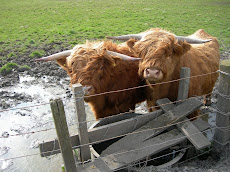Reivers - Pele Towers of the Anglo\Scots Border
Fortified Homes gave the Border Reivers a Haven against Attack
In a land that was often ravaged by war, even in peace subject to attack from neighbours and raiders from the opposite realm, pele towers were the last line of defence.
There are yet to be seen many of the pele towers built in the 14th, 15th and 16th centuries on each side of the English Scottish Border. They stand today as a reminder of a time when no-one who lived in the Border lands was safe from attack by marauding army during the clash between England and Scotland known now as the Scottish War of Independence, enemy from the opposite side of the Borderline intent on retribution for previous attacks on their homes or even close neighbour of the same nationality, at odds as a result of the interminable, relentless feuds that infested the Border families. Feud was the canker of the Border lands. For centuries, neither Border Law nor the civil or criminal authorities of the two countries, however hard they tried, could eradicate or even curtail it. Feud ruled in the Borders. It was just one more reason for the defensive approach which resulted in the building of the fortified towers known as 'Peles' or 'Peels'.
There are many definitions of the word 'pele'. It is accepted now that it originates from the old French meaning a stake. From this it would seem that initially it meant that the ground was defended by a palisade or fence, the fortified tower within it eventually taking the name.
The Towers Built to Withstand a Siege
The towers were very strongly built with walls between 4 and 15 feet thick. (Cessford castle or tower in the Scottish Borders has walls of fifteen feet thick in places). Often they were 'rubble' built, using random sized stone, sometimes 'ashlar' or cut to perfect proportions. They were usually three storeys high although 4 and 5 storey examples still exist, making them anything up to 50 feet high.. Atop the highest storey there was a metal basket primed with wood. This would be fired should any enemy be seen approaching. As there was usually another tower within sight or relatively near at hand, the fire would be seen by others of the clan. Within minutes the whole valley would be aware that an enemy was near at hand. There was only one door, wide enough to let only one man pass at a time. It was in almost every case a double door, the inner of strong studded oak with an iron one, known as a 'yett', positioned in front of it.
Residence of the Laird or Clan Leaders
The towers were beyond the means of the rank and file members of the sect or 'grayne' of the clan that owed allegiance to the Laird or Chieftan. They usually lived in very primitive dwellings outside the walls, built as in the times of the Ancient Britons from 'wattle and daub'. The advantage of such a home was that it could be replaced within the day should a raid result in it being fired. This happened with monotonous regularity. There was nothing to be gained from building in stone.
The Security of the Tower in Times of Attack
Surrounding the tower a high wall was built, anything up to 16 feet high and 3 feet thick. This was positioned some way from the tower to provide extra defence. It was known as a 'barmkin' or 'barnekin' wall. Should an enemy come screaming over the horizon, the dwellers outside the walls would gather up as much of their domestic and farming implements as they could and drive any beasts they owned within the barmkin wall. Then they would enter the tower itself and help the Laird to defend both the tower and their livelihoods.
The Ground Floor of the Towers
The ground floor of the tower usually had a vaulted ceiling. The construction of this was of paramount importance as the stability of the floors above depended upon its strength. It was in this area that the Laird would drive his horses and any other beasts that it was capable of holding when attack loomed. The horses were of ultra-importance; they were needed when the Laird went out on one of his nightly forays to exact retribution for the latest attack on his tower or needed to steal a few beasts to furnish his table or cater to the needs of his dependents.
The Upper Storeys
In a three storey tower, the most common type, the middle floor was the living quarters. It was the equivalent to the great hall of buildings of a more refined nature. There was a massive fireplace in one wall and the floor was strewn with sweet-smelling grasses that could be changed on a daily basis. Windows were a rarity, as much for the comfort of the residents as to prevent entry should scaling ladders ever get near enough to endeavour entry. In some examples of the Border Pele there were little rooms cut into the walls which were curtained in an effort to provide some privacy. Above the living quarters, on the third floor, were the bedrooms.
In the valley of the river Liddel there were upwards of 70 towers or fortified places, some of stone others of wood. They were a refuge for all the folk living in the valley in a violent time in the history of England and Scotland. Throughout modern day Cumbria, Northumberland, and the whole of Scotland south of the river Forth there are many examples of the Pele Tower, testimony yet to a violent age now gone but not forgotten.
Since the day I learned to read I have been passionately interested in history; all history, all places and all people. Naturally, being English, I have an affinity with British history as its heritage is within relatively easy reach.
In 1985 I moved with my job to the Scottish Borders and fell in love with the place. There it was a surprise to find out that I knew nothing of the Border Reivers, the lawless clans who held sway in the Border country for centuries. I found their history to be absorbing and fascinating and today, twenty-five years later, the enthusiasm and passion shows no sign of waning. I am a fully qualified textile technologist and am often asked how I equate an interest in history with a profession that encompasses the physical and chemical properties of yarns and cloth and machinery precision.
Strange bedfellows indeed! I find my outside interest in history to be a perfect foil to my work and consider myself blessed that I have a passion in both camps. I have written a book about the most infamous Scottish Border Reiver of the 16th century. He was known as Kinmont Willie Armstrong. The Book is called 'Deadlock and Deliverance'. Currently I am writing yet another book about the Northern Rebellion of 1569/70 which involved the Scottish Border Reivers.
http://www.reivershistory.co.uk
Article Source: http://EzineArticles.com/?expert=Tom_W_Moss
Subscribe to:
Post Comments (Atom)











No comments:
Post a Comment